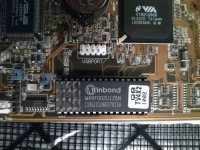I believe one of the main reasons may be the interleave setting. By default it seems to be disabled... On the MD2001 most (not all) dram performance options are already enabled. That's why it runs mostly great. Let's open
@Strikeeagle1977 RG file in a random Hexeditor and have a look... It's these values for the proposed Bytes:
50 = FDh
51 = D8h
64 to 67 = 95 52 52 00h
6A = 86h
Wir dröseln mal auf:
Byte
6A ist Tref (Refresh Counter). VIA gibt folgendes an:
86h (Hexadezimal, also 134 dezimal) bedeutet nun, dass der Refresh alle 134 x (16-1) Takte durchgeführt wird. Das wäre also eine Tref von 2010 Takten.
Byte
64 bis 67 sind die Primärtimings für den Ram. Ich tippe je ein Byte pro Slot. Ich vermute bei diesem System steckt aktuell nur Ram in Slot 2 und 3 (Bytes 65/66 mit jeweils 52h gesetzt):
52h ist binär
01010010. Achtung, wir sind little Endian, sprich das niedrigste Byte ist rechts bzw. wir lesen von oben nach unten im SCreenshot durch:
Trp = 0 = 2T
Tras = 1 = 6T
CAS = 01 = 2T
DIMM Type = 0 = "Standard"
ACTIVE Command = 0 = 2T
Bank Interleave = 10 = 4-way
Byte
51h und
50h bleiben noch übrig:
51h ist binär
11011000 und 50h ist
11111101.
51h:
CPU Read Dram 0WS = 1 = enable
CPU Write Dram 0WS = 1 = enable
reserved
Fast response = 1 = enable
non-posted IOW = 1 = enable
50h:
CPU IOQ = 1 = 4-Level
Read around write = 1 = enable
reserved
Derefer Retry HLOCK = 1 = enable
reserved
reserved
reserved
CPU PCI Master Read DRAM Timing = 1 = start before snoop complete


 Es ließ sich danach auch keine andere Version mehr drüber flashen. OK, reset, vieleicht bootet das Board ja noch. Nix da, kein Ton mehr. Das war mir das letzte Mal vor 20 Jahren passiert. Was nun?
Es ließ sich danach auch keine andere Version mehr drüber flashen. OK, reset, vieleicht bootet das Board ja noch. Nix da, kein Ton mehr. Das war mir das letzte Mal vor 20 Jahren passiert. Was nun?

